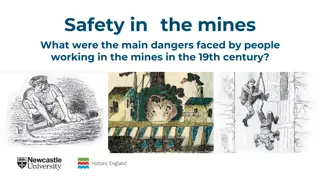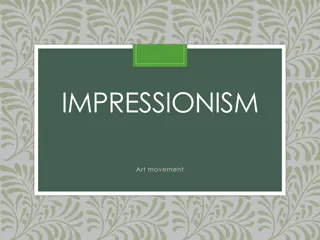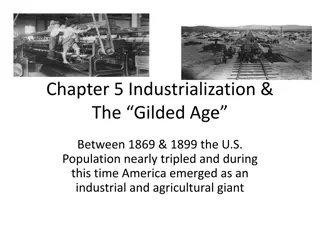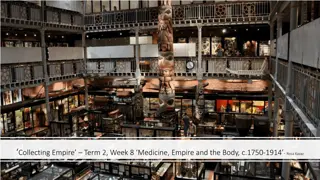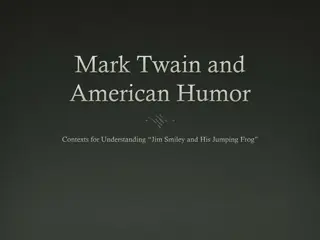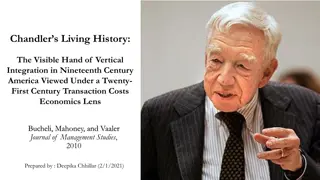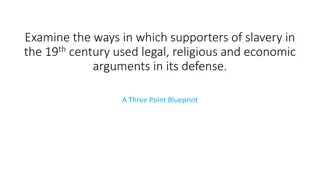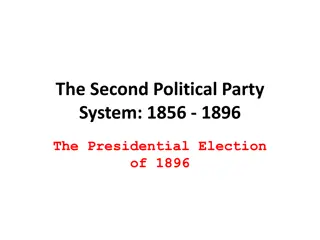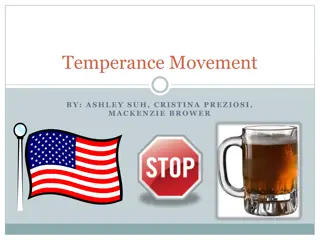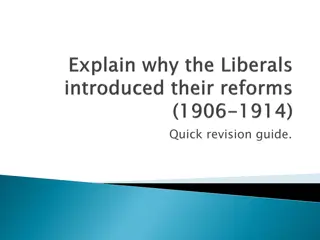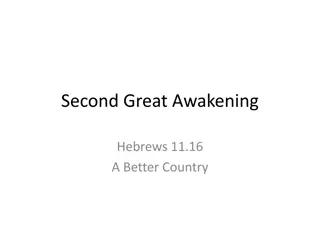Contrasting Perspectives of America in the 19th Century
The content delves into the societal, economic, and political disparities between the North and South of America in the mid-19th century, highlighting differences in literacy rates, economy, agricultural practices, and labor systems. While the regions shared a common history and political system, they diverged significantly in societal structures and cultural aspects, reflecting contrasting paths of development and contributing to rising tensions over issues like tariffs, slavery, and westward expansion.
Download Presentation

Please find below an Image/Link to download the presentation.
The content on the website is provided AS IS for your information and personal use only. It may not be sold, licensed, or shared on other websites without obtaining consent from the author. Download presentation by click this link. If you encounter any issues during the download, it is possible that the publisher has removed the file from their server.
E N D
Presentation Transcript
Revision America As Debates
Consider the preamble to the Spec: It explores concepts such as political authority, abolitionism and social justice. It also encourages students to consider what creates social tension and harmony, the idea of nationhood and the issues surrounding political compromise. Think about how you can relate this to what you studied: C1845- the introduction to what America was like and the legacy from the past. 1846-1850- Mexican War and Compromise 1851-54- Growth of abolitionism and the reaction to it 1854-1860- The growth of sectional tension, rise of new parties and decline of old ones. 1860-61- the coming of War.
America in C1845: Think about- Is America united or divided? Do the North and South have more in common or more that is different? Are political relations good or is there clear tension Are Social/ Economic or Political differences the most significant? What impact is their from the past? (The Constitution, Missouri Compromise/ Nullification) Was Westward Expansion the cause of tension?
North and South were Different c1845 SOCIAL/ECON: Literacy rates were high in North (New England- 95% of the adult population) but in the South literacy rates were low in the white population (80% of adults) and education was stopped/ illegal amongst the slave population meaning most slaves were illiterate. SOCIAL/ECON: The North was urbanising as a society whilst in the South was not and remained rural and there were very few cities or towns. The growth of Urban areas in the North was increased by the arrival of immigrants. In the south there was little new immigration. Immigration meant that Northern and Southern society became notably different in terms of culture, economic system and population. ECON/ AGRICULTURE: Southern states economy was based on cash crops (tobacco, sugar cotton) this meant farming in the South was based on large plantations and significantly different to farming in the North which was based on smaller farms growing food crops/ animals. ECON: Southern states favoured low levels of tariffs whilst the Northern states wanted high levels of tariffs to protect their industry against European imports; this difference was highlighted in the Nullification Crisis ECON: the North s workforce was based the principle of waged labour such as factory workers, whilst the southern economy was largely based on slave labour
No they werent HISTORY: The states shared a history including the defeat of the British in the War of Independence POLITICAL: The North and South had the same political system along with shared beliefs in key freedoms as set out in the Constitution and the Bill of Rights (for white, middle class men at least). State governments were modelled on the federal system. CULTURE/ Society: American culture was built around the people building a life for themselves and seeking opportunity. The American dream of making your fortune and promise of religious freedom encouraged immigration into America. Amongst the people ideas such as the frontier spirit and seeking adventure and fortune helped Westward expansion in the 1840s. ECON: the states in America all states had a shared currency. There was a great deal of trade between the states and this meant that there was a close inter-relationship between different states in their economic activity for example finance and shipping industries in New York and cotton producers in Virginia. This meant that states in the North were reliant on states in the South to help them do well economically (buy their industrial products, and states in the South were reliant on states in the North to help them to do well. ECON: America was predominately an agricultural nation with the more of the population in both the North and South working in agriculture than in any other industry. (Can you find figures)
Further actions: Make sure you have lots of data and statistics about the differences/ similarities between the North and South c1845: Population Urbanisation People working in agriculture Industrial output/ production Literacy rates Anything else you can find
The Missouri Compromise was effective the Compromise lasted 30 years and had ensured clarity on the position regarding the expansion of slavery for this period of time. It gave a mechanism for the maintenance of balance between the Northern and Southern states the annexation of Texas took place in 1845 under the Missouri Compromise and crisis was averted. Polk was elected President in 1844 on the basis of a promise to annex both Texas and Oregon maintaining the North/South balance and Missouri Compromise Arkansas entered the Union under the terms of the Compromise without Sectional issues suggesting the Compromise was effective the Compromise had widespread support in the North and South and therefore reduced sectional tension.
The Missouri Compromise was ineffective the Compromise was widely seen as being fundamentally undemocratic and therefore flawed and unlikely to survive a strong challenge. The idea of popular sovereignty started to receive greater support the Nullification Crisis highlighted how divisions existed between North and South despite the Missouri Compromise the Missouri Compromise led to strong division over the expansion of America, most notably over the idea of acquiring land from Mexico and potential annexation of Cuba in the South many were unhappy that the Missouri Compromise created the precedence that Congress could make laws regarding slavery. However, in the North many were unhappy with the Compromise as it allowed the expansion of slavery suggesting the Compromise was failing to please either the North or South.
America stable and division limited in c1845 The two major parties the Democrats and the Whigs were both national parties with representatives and voters in both the North and South. This is vitally important as it means that the parties didn t promote North over South or vice- versa. Strong contrast to the late 1850s. The Missouri Compromise meant that tension between the North and the South was limited as the entry of new states (from within the Louisiana Purchase) being largely smooth (look up what states were added from 1820-1850) State governments largely mirrored the systems at Federal level and maintained the rule of law. The Constitution was supported in both the North and South and both believed in democracy and the Union (some limited exceptions in South Carolina). Confrontation such as the Nullification Crisis had been solved (sort of) with attempts made to find compromise (led by Henry Clay)
Oh no it wasnt The division over the issue of slavery was a cause of division/ lack of stability and in particular where slavery should be allowed and whether it should spread to any new territories/ states added to the USA through westward expansion. The issue of tariffs and economic policy caused division and potential instability as the Northern people wanted to protect their industry from foreign competition, in particular from Britain (leading to a desire for protective tariffs), whilst the South as which wanted cheap industrially produced goods and was a strong exporting economy (cotton, tobacco, sugar) did not want tariffs. This was highlighted with the Nullification Crisis. the entry of Texas into the Union in 1845 caused a degree of tension (notably over how many states it should become) and its entry meant that the North was behind the South in terms of number of states- impacting on the Senate and electoral college. the size and nature of the population in the North was changing much more and more rapidly than in the population in the South. This was significant in terms of the religious and ethnic origins of the new immigrants (not WASPS) and the sheer numbers. There was growing tension as the South believed that the North would come to dominate especially with control of the House of Representatives meaning the balance of the Senate became of the upmost importance.
Past events meant there was a lack of unity in America c1845 The Constitution was vague on the issue of slavery (only issue explicitly addressed is that slaves counted 3/5ths of a person in the calculations of how many seats a state got in the House of Reps. And in the electoral college) The need for the Missouri Compromise highlighted the division over the expansion of slavery going forward with further Westward Expansion. The need for balance set out in the Missouri Compromise between Slave and Free states highlights the fact that the two section saw themselves as distinct and having. The Nullification Crisis showed significant lack of unity (would have been much worse if rest of South had supported South Carolina). The concessions made by Clay suggested to the South that challenging the North could bring significant benefit.
Before the Mexican War Could you foresee an American Civil War? How well were the various Compromises working? Were extremists in the North and South a Minority or Majority?
The Mexican War and the 1850 Compromise How much tension was caused by the Mexican War and taking of Mexican territory? How effective were the attempts at political compromise 1846-1850? How good a job did the key politicians do 1845-1854? (Zachary Taylor, Stephen Douglas, Henry Clay, Daniel Webster, John Calhoun)
Mexican War and 1850 Compromise Polk s war- seen as an act of Southern aggression. Quest for new slave states? Polk treating Oregon/ Britain and Canada differently to Mexico. Wilmot Proviso- Start of Northern attempts to restrict expansion of slavery. Calhoun s Southern Doctrine- Threat of secession, defence of slavery and the expansion of slavery. 1850 Compromise sorts out the differences?
Western expansion was important in the deterioration of relations between North and South by 1850 the Missouri Compromise maintained the balance between Free and Slave states, western expansion and the admittance of new states threatened this compromise. North/South divided over the war with Mexico and the Treaty of Guadalupe Hidalgo the Wilmot Proviso and Calhoun Doctrine the doctrine of popular sovereignty as a compromise idea to prevent a split between North and South, suggesting that the issue of western expansion was key the controversy over California and New Mexico.
Western expansion was not important in the deterioration of relations between North and South by 1850 the growth of Abolitionism in the North and Southern fears about this movement Southern anger at the North failure to abide by 1793 law regarding runaway slaves and the work of the underground railway Northern condemnation of slave trading in Washington DC the growing differences in population between North and South saw Northern domination of the House of Representatives causing unease in the South the economic differences between North and South saw growing disparity between what policies the two supported in terms of trade and industry the increasing move to voting being on sectional rather than party lines.
1850 Compromise Role of Clay, Webster and Douglas Resistance of Calhoun and others What were the terms? What did the South gain? (Fugitive Slave Law) What did the North gain? Was it doomed to fail? (remember Davis source)
1850 Compromise How long did the 1850 Compromise hold? What were its key strengths? What were its key flaws? Could the differences really be removed through Compromise?
1850-1854 Growth of Abolitionism and Southern Reaction How much did abolitionism grow? Was the grow of abolitionism due to political leaders such as William Seward and John Brown or due to the popular press (such as William Garrison s Liberator) or popular literature (such as Uncle Tom s Cabin )? Was the reaction to abolitionism driven by political leaders or popular press and literature? Was the reaction of the southern political leaders and press exaggerated? Or unfounded? Produce bullet points on the above
By 1855 the USA was strongly divided YES: Uncle Tom s Cabin stirred abolitionist feeling in the North and defence of slavery in the South leading to increased sectionalism which appeared unrepairable YES: by 1855 the Whig Party had collapsed and there were serious division in the Democrat Party and serious division in Congress YES: events in Kansas in 1854 1855 demonstrated the depth of division. Students may use the following to show disagreement with the statement: NO: President Fillmore s administration following the 1850 Compromise (1850 1853) was a period of relative tranquillity NO: Douglas did not intend to increase sectionalism over Kansas-Nebraska and accusations of a slave power conspiracy were misplaced NO: there remained significant commitment to the union.
Bleeding Kansas caused the tension in the USA 1850-56 Kansas was flooded by pro-slavery voters from Missouri. Kansas became a symbol of the wider tension the outbreaks of violence in Kansas increased tension and the belief that compromise was no longer possible the reaction Northern journalists, who blew out of proportion the sack of Lawrence by a pro-slavery posse Bleeding Kansas raising John Brown to national attention Bleeding Kansas became a rallying cry for those who opposed what they believed to be Slave Power .
Other factors caused the tension other issues that hardened attitudes such as the publishing of Uncle Tom s Cabin and (1852) Bleeding Sumner (1856) the issue of the potential annexation of Cuba and the filibuster expedition caused a great deal of tension (e.g. Lopez expedition 1850) national political factors such as the emergence of the Republican Party (1854 6), and the split in the Democrats (1856) played a key role in increasing tension between North and South the actions of southern political leaders and calls for secession de- stabilised relations as did the Northern States attempts to negate the Fugitive Slave Act. (1850).
1854-1860 Tension and Secession Which event was most important in the rise Republican Party? (Bleeding-Kansas, 1856 Election, Dred Scott, Panic of 1857, Lincoln Douglas Debates) Key figures in the Republican Party (Lincoln, Seward, Chase) Which event was most important in the rise of Sectional tension? (Bleeding-Kansas, 1856 Election, Dred Scott, Panic of 1857, Lincoln Douglas Debates)
The rise of the Republican Party: Stage 1 1856 The Know-nothings (American Party) national convention for the 1856 election saw the party split over the issue of the repeal of the Kanas-Nebraska Act. This and other problems in the Know- Nothings helped increase the support for the Republican Party in the North. The failure of the Know-nothings was key in the rise of the Republicans especially as the levels of migration dropped, the Know-nothings failed in state government and increasingly looked like the Whigs with a new name and focus shifted to tension over the expansion of slavery. The Republicans were doing well in 1856 as Fr mont won all but 5 of the free states in the presidential election and over 1.3million votes on a campaign based on the slogan Free Soil, Free Labour, Free Men, Fr mont. Coming second in the election was impressive for such a new part. Remarkably victory in a few more states would have given them victory in the election. Bleeding Kansas gave the Republicans a clear cause going into the 1856 election uniting the party whilst the election brought out the divisions in the other Parties. The anger created in the North directly linked to rising Republican support. However In 1856 despite the unpopularity of the previous Democrat President Pierce, James Buchanan (Democrat Candidate) comfortably beat Fr mont
The rise of the Republican Party Stage 2 1856 to 1857 The beating of Charles Sumner by Brookes caused outrage in the North, highlighting the perceived violence and brutality of the South held by many in the North. This and the sympathy for the Republican Sumner bolstered the Republican party and damaged the Democrats. The disastrous Presidency of Buchanan s: pushed most Northerners into the Republican Party. The pro-slavery Lecompton constitution in Kansas was backed by President Buchanan and this led to an angry reaction in the North increasing Republican support Buchanan s handling of the Dred Scott decision damaged the Democrat s in the North and bolstered the Republicans as he denied knowledge of the decision at his inauguration despite being seen in extensive discussions with the Chief Justice Roger B. Taney.
The rise of the Republican Party Stage 3 57-58 the Panic of 1857 bolstered Republican support based on their proposed economic policies and the Northern perceptions of the failures of the Democrats in dealing with the problems. The Lincoln- Douglas (1858) debates were key in the rise of the Republicans as the performance of Lincoln (although unsuccessful in the race for the Senate) gained national coverage and his speeches were well received across the North helping launch him towards a successful Presidential campaign in 1860.
Rise of the Republicans Which is the most important reason/ stage for the rise of the Republican s? How do you measure their rise? How does the rise of the Republican s link to increased sectional tension? How does the rise of the Republican s link to theother political parties?: Whigs Know Nothings Democrats
Growth of Sectional Tension The tension between the North and south grew because: Kansas-Nebraska Act and Bleeding Kansas highlighted the differences over slavery and the expansion of slavery which led to significance violence. The North increasingly feared a slave power conspiracy whilst the South increasingly viewed the North as attacking their way of life . The collapse of the Whig party and emergence in particular of the Northern only Republican Party shifted American politics and made them far more sectional
Growth of Sectional Tension The beating of Sumner heightened tension and led to greater fear of slave power whilst bolstering Republican support in the North. The Dred Scott case of 1857- a huge victory for the South a devastating blow for the opponents of the expansion of slavery and for some proof of a slave conspiracy at the heart of Federal Government (President and Chief Justice of the Supreme Court) The Panic of 1857- economic crisis that hit the North really hard leading to mass unemployment but left the South untouched as the demand for King Cotton hit new heights. This led many in the South believe that they could/ should operate economically as a separate country.
Growth of Sectional Tension The Lincoln Douglas Debates: Douglas was a significant figure in and a potential future Presidential candidate meaning there was a great deal of focus on his campaign in 1858 the debates were seen as a test for whether the Democrats could successfully address the issue of slavery and remain a united national party. Lincoln s House Divided speech played a role in increasing sectional tension immediately and the South s memory of his stance was hugely significance when Lincoln stood for and won the Presidency in 1860. Douglas support for the Freeport doctrine and popular-sovereignty came under close scrutiny.
1860/61 Election and WAR!!!! Significance of the Election of Lincoln (1860) Why was there a War?
Democrat Split The split in the Democrat party going into the 1860 election was key in causing increased sectional tension: The Northern and Southern Democrats clashed at the Conventions. Douglas could have possibly appealed in North and South but this clearly not the right approach for the Southern fire-eaters . The Democrat split made it more straightforward for Lincoln to win the election and highlighted the sectional nature of politics in 1860.
Election of Lincoln and Secession Lincoln s election with no electoral college votes from the South was a significant step to War. South Carolina seceded immediately followed by other Southern States. Blame can be placed both with Southern politicians and with Lincoln and his administration for failing to find compromise.
Growing Sectional Tension/ War Rank events 1854-1860 in terms of the amount of tension they cause? When does war become A) likely? B) Inevitable? Which is the most important event By the end of 1856? By the end of 1857? By the end of 1858?
Were Southern Politicians responsible for the War?- Yes it was Southern politicians who pushed for and led Secession from the Union which started the war and the confederate leader, Davis, ordered the taking of Fort Sumter starting the war South Carolina and the other seceding states can be argued to have acted irrationally given Lincoln s stated position on slavery and the constitutional constraints on his power, particularly as the Republicans did not control Congress Lincoln, on becoming President, was conciliatory but firm and Congress did seek compromise, but Southern politicians largely refused to enter into any discussion of compromise Lincoln at the time, and some historians since, believed that the war was a result of a slave power conspiracy in which the Southern politicians from the planter class conned the Southern voters into secession and war.
No the war between the two sections can be seen as being due to the long standing differences and tensions between North and South. Attempts at compromise had been exhausted and only conflict would resolve the issues the Southern politicians represented the views of the Southern people who had been whipped up into an emotional fever at the time, largely by fire- eaters from outside the political mainstream. Without popular support secession and war would have not followed Lincoln and the North could have allowed secession and avoided war, the Confederacy wanted peaceful co-existence some have argued that Lincoln manoeuvred the situation at Fort Sumter so that the Confederacy would fire the first shots of the war, suggesting Lincoln was responsible for the start of the war.



